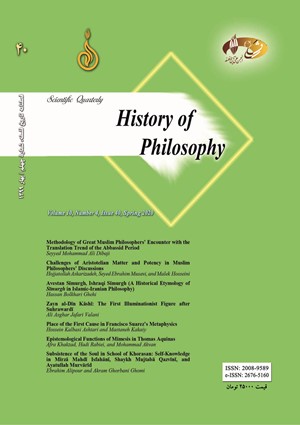Epistemological Functions of Mimesis in Thomas Aquinas
Subject Areas : Geneology of philosophical schools and IdeasAfra Khakzad 1 , Hadi Rabiei 2 , Mohammad Akvan 3
1 -
2 -
3 -
Keywords: Art Aquinas Mimesis Aristotle Beauty Augustine ,
Abstract :
Thomas Aquinas, who was inspired with Aristotle’s philosophy in developing some of his views, followed his path in considering art as a kind of imitation. However, the concept of imitation for him was not a purely Aristotelian one; rather, it was also influenced by the viewpoints of some thinkers such as Augustine and Pseudo-Dionysios the Areopagite. He employed mimesis in the texture of Christian theological discussions as well as in relation to the issues related to the metaphorical language of holy texts. Therefore, the concept of mimesis in Aquinas’ view was faced with an epistemological dilemma. On the one hand, it could result in both anxiety and relaxation in addressees or perhaps, through affecting their imagination, distract them from the path of rationality. On the other hand, it seems that the language of the Holy Book, which has been written for leading its addressees to the path of intellection and religiosity, shares the same features of the language of artistic works. Different types of mimesis have been used in the Holy Book and, more importantly, the relationship between the world of being and God is explained there on the basis of the concept of mimesis or imitation. In this paper, through analyzing the views of Aquinas and his references to such philosophers as Aristotle, Augustine, and Pseudo-Dionysius the Areopagite, the authors try to provide a clear explanation of the concept of mimesis and the epistemological functions of artistic imitation in Thomism.
ابنسینا (1386ق) الشفاء، المنطق، الشعر، حققه و قدمه عبدالرحمن بدوی، قاهره: الدار المصریه للتالیف و الترجمه.
کتاب مقدس: عهد عتیق و عهد جدید (1388) ترجمه فاضل خان همدانی، ویلیام گلن و هنری مرتن، تهران: اساطیر.
Aquinas, Thomas (1952). The 29 Questions on Truth (from The Disputed Questions on Truth). translated by W. Robert and S. J. Mulligan. http://www.documentacatholicaomnia.eu/03d/1225-1274, Thomas Aquinas,_The_29_questions_on_ Truth_(Mulligan_Translation),_EN.pdf.
Aquinas, Thomas (1995). Commentary on Aristotle's Physics. translated by Richard J. Spath and W. Edmund Thirlkel. Blackwell.
Aquinas, Thomas (1961). Commentary on the Metaphysics. Book 1. with English translated by John P. Rowan. Chicago: Henry Regnery Company; https://logicmuseum.com/wiki/Authors/Thomas_Aquinas/metaphysics/liber1#Lecture_4.
Aquinas, Thomas (1970). Commentary on the Posterior Analytics of Aristotle. translated by F. R. Larcher with a preface by James A. Weisheipl. Albany, N.Y.: Magi Books; https://www.logicmuseum.com/authors/ aquinas/posterioranalytics/aquinasPA1-1-8. htm.
Aquinas, Thomas (1980). Commentary on the Sentences. in S. Thomae Aquinatis opera omnia. edited by R. Busa. vol.1. Stuttgart–Bad Constant: Frommann Holzboo.
Aquinas, Thomas (1994). In Librum beati Dionysii de divinis nominibus exposition. translated by Harry C. Marsh. in Cosmic Structure and the Knowledge of God: Thomas Aquinas. Ph.D. diss. Vanderbilt University. pp.265–549.
Aristotle (1995). Poetics. edited and translated by Stephen Halliwell. Cambridge, Mass: Harvard University Pres.
Aristotle (2006). Physics. translated with Introduction, Commentary, Note on Recent Work and Revised Bibliography by William Charlton. Oxford: Clarendon Press.
Aristotle (2016). Metaphysics. translated by C. D. C. Reeve. UK: Hackett Publishing Company.
Augustine (2002). Eighty-Three Different Questions (Fathers of the Church Patristic Series). translated by David L. Mosher. Washington DC: Catholic University of America Press.
Augustine (2012). On the Trinity. translated by Arthur West Haddan. New York: Create Space Independent Publishing Platform.
Curran, (2012). Aristotle, in Aesthetics: the Key Thinkers. edited by Alessandro Giovannelli and Contributors. London: Continuum.
Dionysius the Areopagite (1894). The Celestial and Ecclesiastical Hierarchy. translated by John Parker. Harvard University Press.
Maurer, A. A. (1983). About Beauty: A Thomistic Interpretation. Houston, Tex.: Center for Thomistic Studies.
Murray, P. (2013). Aquinas at Prayer, The Bible, Mysticism and Poetry. UK: Bloomsbury.
Preminger, A., Brogan, T. V. F. (1993). The New Princeton Encyclopedia of Poetry and Poetics. Princeton: Princeton University Press.
Rolt, C. E. (2000). Dionysius the Areopagite: On the Divine Names and the Mystical Theology. London: Grand Rapids. MI: Christian Classics Ethereal Library.
Tatarkiewicz, W. (2011). A History of Six Ideas: An Essay in Aesthetics. Netherlands: Springer.
Tück, J. (2018). A Gift of Presence: The Theology and Poetry of the Eucharist in Thomas Aquinas. Washington, DC: Catholic University of America Press.


